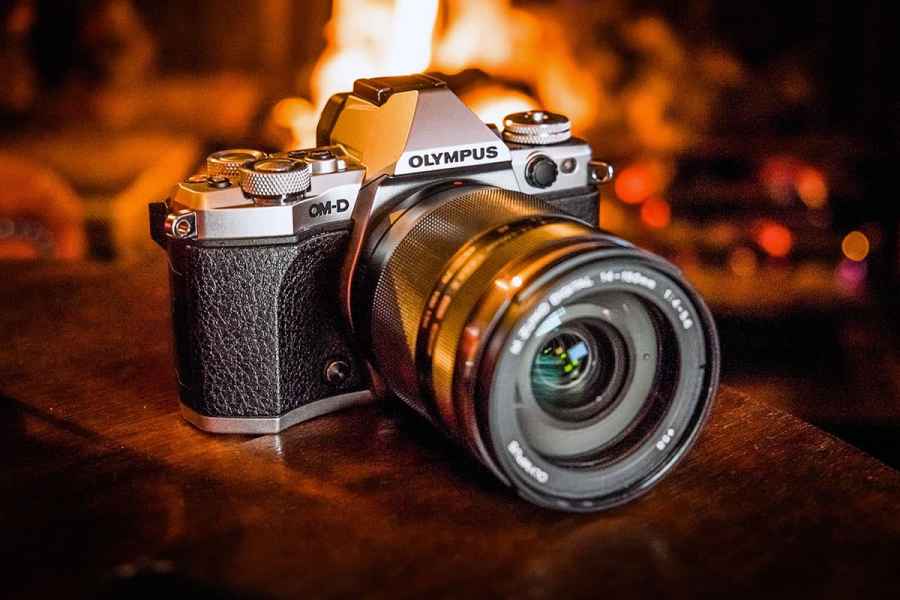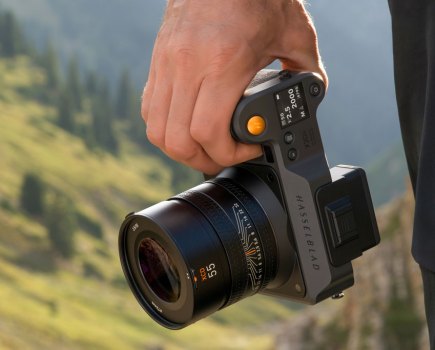Olympus OM-D E-M5 Mark II Review – Hands-on First Impressions
Two years ago, almost to the day, Olympus announced the OM-D E-M5 compact system camera. A premium model with an integrated electronic viewfinder, its styling gave more than a passing nod to the company’s much-loved OM series 35mm SLRs from the 1970s. It grabbed the attention of affection enthusiast photographers in a fashion that previous CSCs had failed to do, and it’s design clearly inspired a range of premium models such as the Sony A7 series and Fujifilm X-T1. Now it’s been updated, with a host of new and improved features.
Olympus OM-D E-M5 Mark II at a glance:
- 16MP Four Thirds sensor
- Micro Four Thirds lens mount
- TruePic VII processor
- 36M dot electronic viewfinder
- 3-inch fully-articulated touchscreen
- Updated 5-axis in-body image stabilisation
- Revised and improved control layout
- Weatherproof construction
- Full HD movie recording at up to 60 fps and 77 Mbps
See our Olympus OM-D E-M5 Mark II sample image gallery
The Olympus OM-D E-M5 II will be available in from late February, for £899.99 body only, £1099.99 with 12-50mm f/3.5-6.3 lens, or £1249.99 with a new, weathersealed 14-150mm f/4-5.6 II lens. The camera will come in black and silver versions.
Key features

The camera will come in various kits, including with this weather sealed version of Olympus’s 14-150mm lens
Like its predecessor, the Olypmus OM-D E-M5 Mark II uses a 16-million-pixel Four Thirds sensor. But it gains an updated processor, the TruePic VII, as previously seen on the flagship OM-D E-M1. With a Micro Four Thirds lens mount, it has access to the most comprehensive range of lenses for compact system cameras, from Olympus, Panasonic and third party makers like Sigma and Samyang.
Other features include a standard sensitivity range of ISO 200 – 25600, with an extended ISO 100 setting also available. Continuous shooting is available at 10fps with fixed focus, or 5fps with autofocus. The maximum shutter speed has been increased to 1/8000sec, and for the first time for Olympus, a fully-electronic silent shutter offers speeds from 1/16000 sec to 60 sec. This helps both with shooting fast lenses in bright light, and in situations where the photographer wishes to be discreet.
The 81-point autofocus system covers almost the entire frame, and naturally includes face- and even eye-detection. However the Mark II has no phase detection elements on its sensor – one of the few remaining areas where it’s still clearly delineated from the E-M1. This only really affects users with legacy Four thirds mounts lenses though.
Naturally the camera includes built-in Wi-Fi for connection to a smartphone or tablet for image sharing and remote control.
Viewfinder and LCD
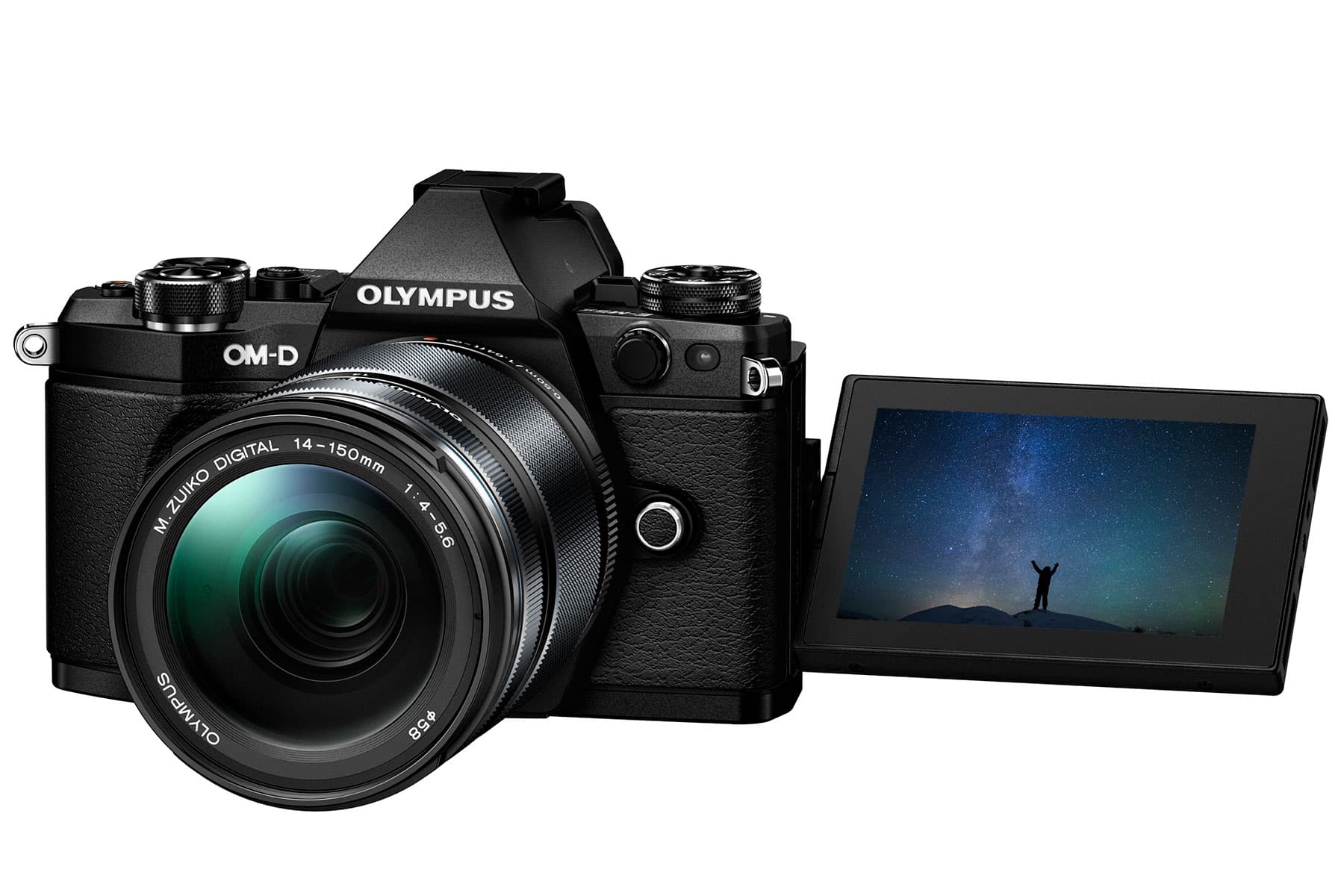
The Olympus OM-D E-M5 Mark II features a fully-articulated touchscreen
Both the viewfinder and screen gain meaningful updates compared to the previous model. For eye-level composition, it has a higher resolution 2.36M dot electronic viewfinder that gives a view similar in size to a full frame SLR. Viewfinder lag is a practically imperceptible 0.01 sec, and Adaptive Brightness matches the display to the ambient light for more comfortable viewing.
The 3” 1.037M dot touchscreen is now fully articulated, rather than tilting only in one direction. For stills photographers this is especially welcome, as it allows use of the LCD as a waist-level finder when hooting in portrait format. One welcome addition is that it’s finally possible to display more-detailed information on a single screen, for example combining the level gauge and live histogram views.
Upgraded image stabilisation
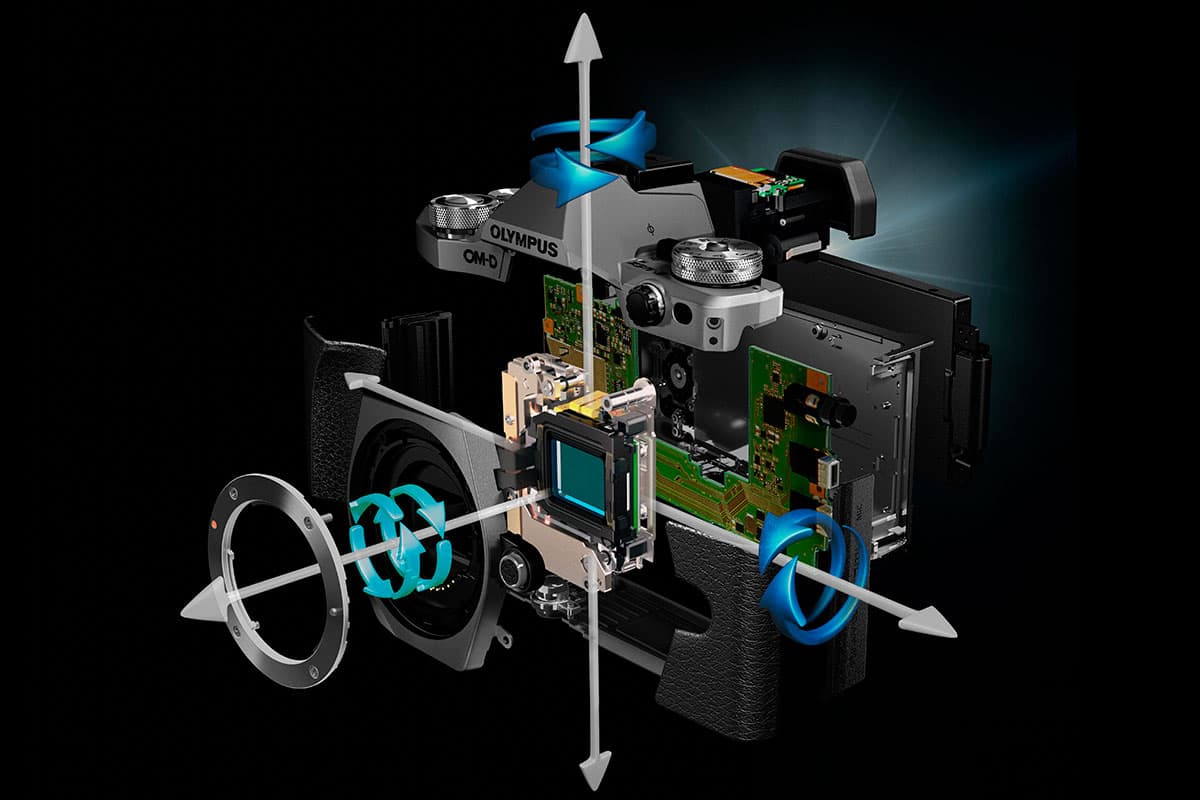
The OM-D E-M5 includes updated 5 axis image stabilisation
The E-M5 Mark II features in-body 5-axis image stabilisation, which works with a practically any lens. Alongside the usual corrections for pitch and yaw, it also corrects for rotation around the lens axis, and up/down and left/right translational movements. This allows better correction for close-up shooting and long exposures. The E-M5’s system worked exceptionally well, but Olympus has further refined it and now promises an extraordinary 5 stops of stabilisation.
Flash

The Mark II’s new FL-LM3 flash unit has a bounce head, and is supplied in the box with the camera
The Mark II doesn’t have a built-in flash, but it comes with a small external hotshoe-mounted unit in the box. In contrast to previous models, though, the weatherproof FL-LM3 is somewhat more useful. It has a guide number of 9.1m (ISO 1000), and a head that can both tilt upwards, and swivel left and right for bouncing the flash. The unit is powered from the camera, and can be used as a controller for wireless flash.
40MP composite stills mode
Grabbing the headlines is undoubtedly the E-M5 Mark II’s new 40-million-pixel composite stills mode. This is implemented by taking eight images and using the camera’s in-body image stabilisation system to move the sensor by 0.5 pixels between each shot. The resultant data is then combined to a single high-resolution image.
This system clearly has significant limitations. The camera has to be used on a tripod, it’s not suitable for moving subject which will blur between frames, and for raw shooters it will produces vast files which may only ever be recognised by Olympus’s own software. It’s nowhere near as practical as buying a 36MP camera like the Sony Alpha 7R if you need that resolution on a regular basis, but it’s an exciting addition to the camera’s armoury nonetheless.
Revised control layout
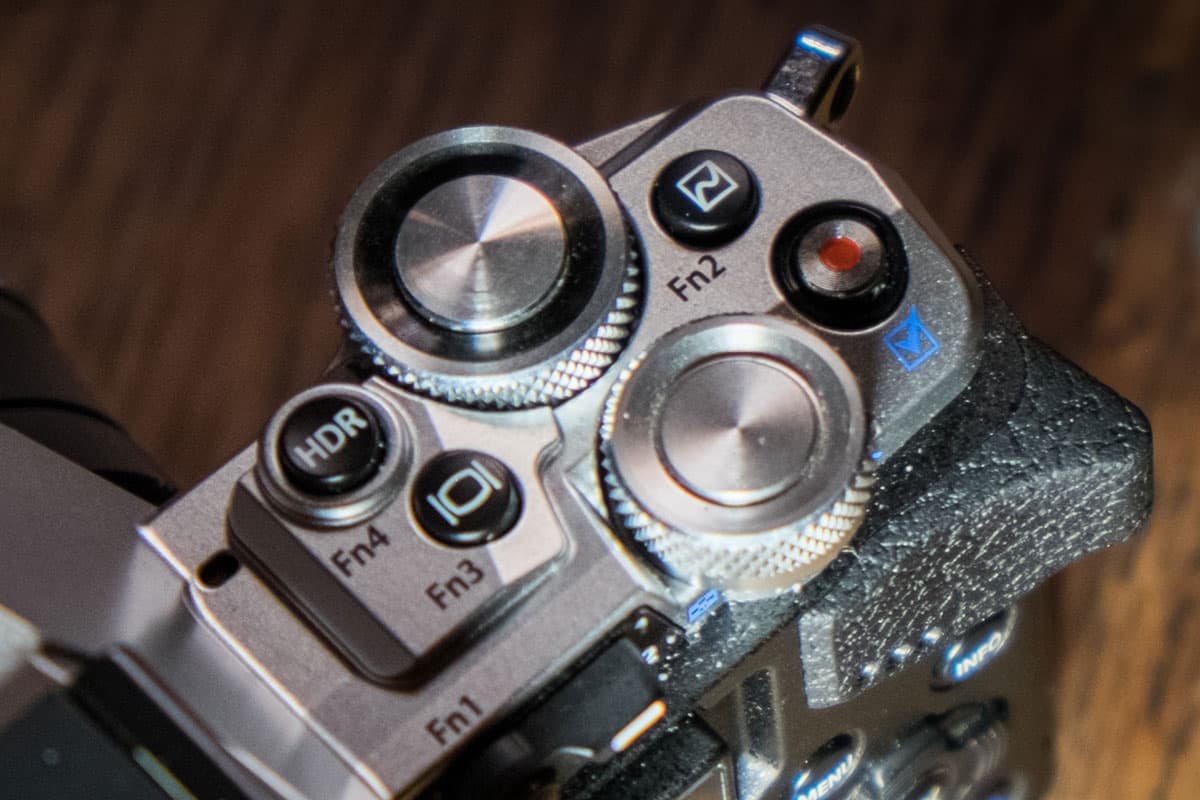
The Mark II’s top-plate controls have been revised for easier operation
The Mark II’s body is more-or-less the same size as the original E-M5’s, but the control layout has been heavily revised and now closely resembles that of the E-M1. For example the twin control dials are now much deeper, and the rear one has been moved so it mow fall directly under your thumb. A large switch on the back allows the dials to be temporarily reassigned to other functions, by default ISO and white balance.
The E-M5’s infamously spongey four-way controller has been replaced by a larger and more positive version, and the mode dial has acquired a toggle locking button. Other buttons have been enlarged and rearranged, and most are user-customisable. The overall result is more practical photographic tool than the original E–M5, which always felt like it needed an extra button or two.
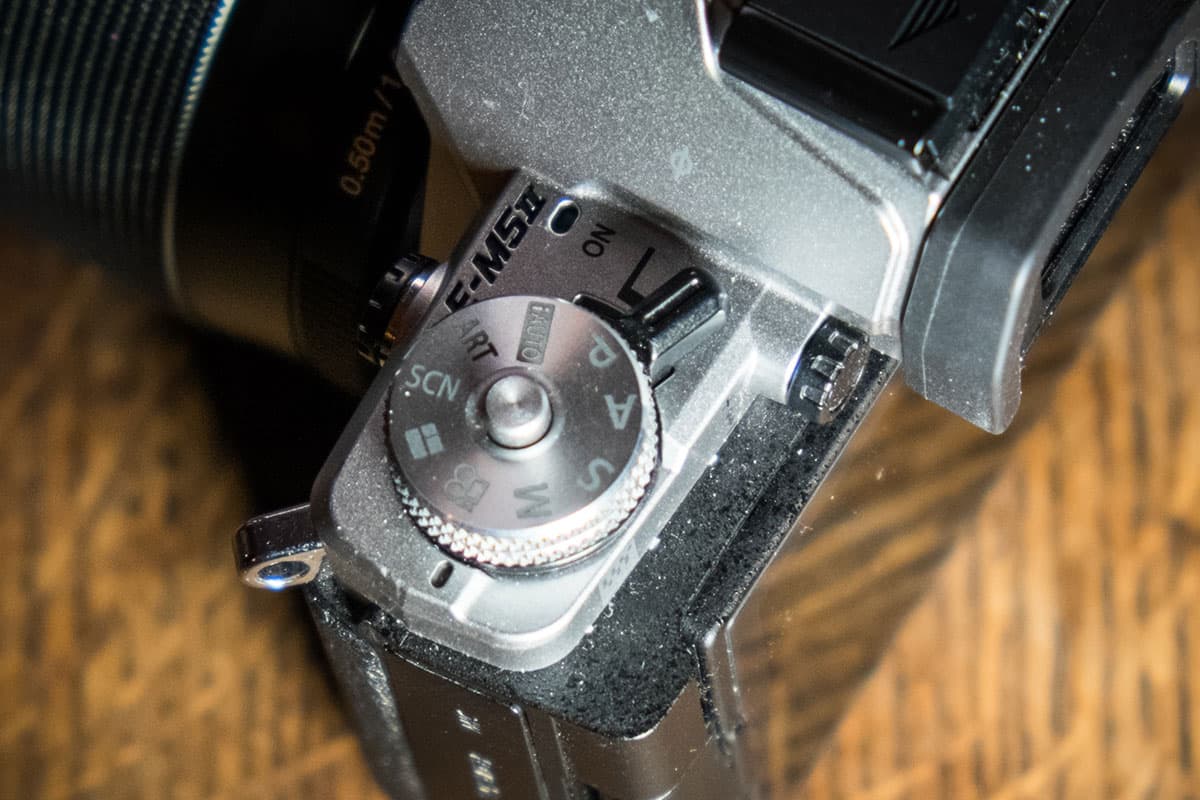
The mode dial gains a toggle lock, and the power switch has been repositioned
The power-switch has been moved from its much-unloved position on the back of the camera, to beside the mode dial on the left top-plate – a position that’s equally-unloved on the E-M1. As most cameras place this important control under your index finger, this is a bit disappointing. However a new power-saving Quick Sleep mode may well make up for this to a great extent.
Improved video
One area where Olympus has legged behind – especially compared to its Micro Four Thirds partner Panasonic – is video. But the E-M5 Mark II promises a real improvement, with a choice of encoding options for higher-quality footage, including All-I at 77 Mbps, and IPB at bitrates up to 52Mbps. A microphone socket is built-in (the original E-M5 required a clunky adapter), and the touchscreen can be used for changing settings silently, including focus pulling.
The Mark II can also output clean video to an external recorder over HDMI – the first Olympus to offer this capability. Timecode information can also be recorded, for syncing footage during post-processing. The in-body image stabilisation system includes further improvements specifically for video, and Olympus’s sample videos show almost steadicam-like quality shooting handheld. It remains to be seen how well this all adds up in practice, but it certainly looks like the E-M5 Mark II should be much more interesting to videographers than previous OM-D models.
New grips
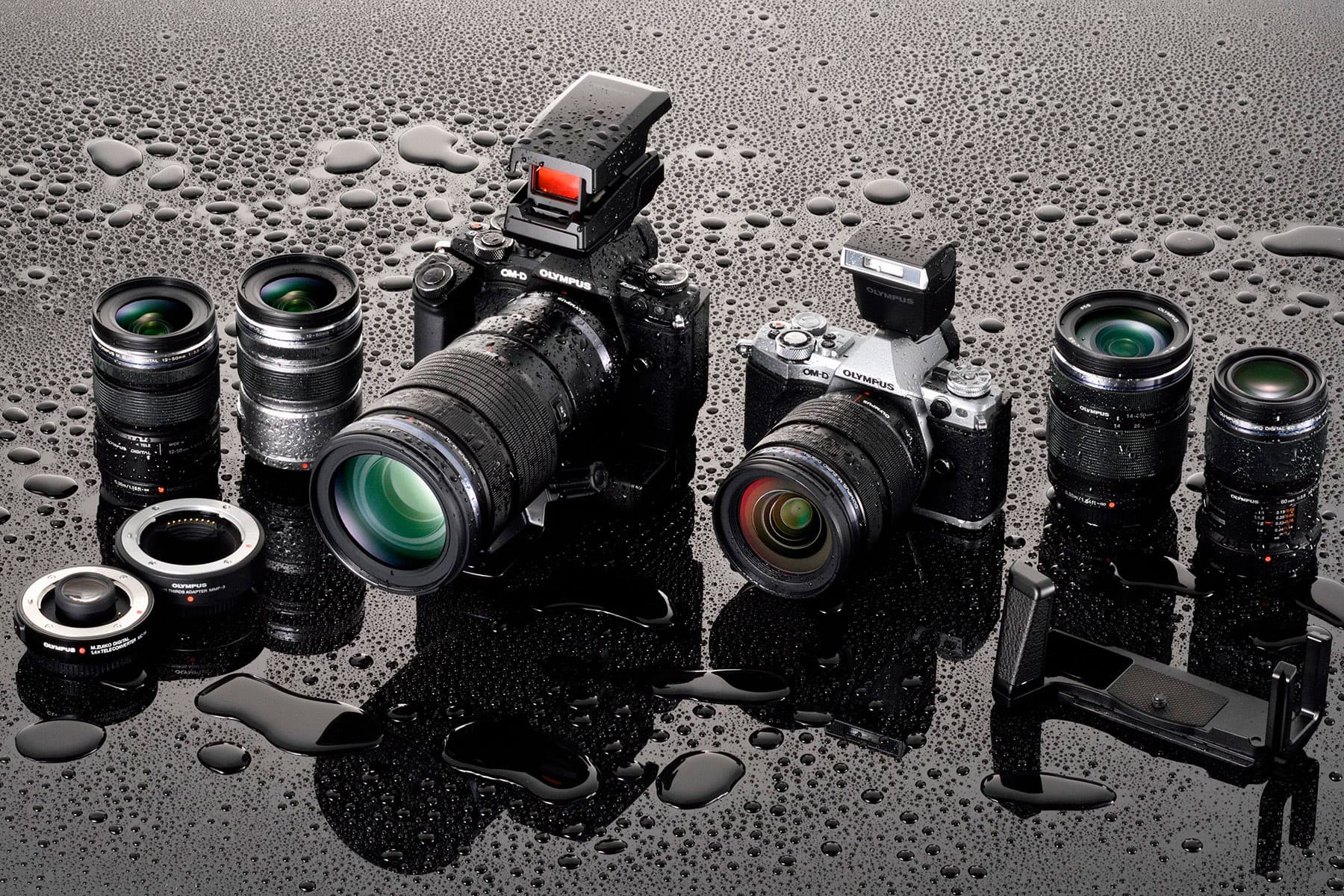
A whole range of weatherproofed accessories is available for the OM-D E-M5 Mark II
One ergonomic revision on the Mark II is a subtly reshaped handgrip. The original E-M5 had just a very miminal grip on the front of the camera, which didn’t provide a great deal of purchase. Its replacement gains a more prominent grip that’s subtly shaped to fit your hand better. It’s a small improvement, but users with larger hands will probably still want to add on an accessory grip.
To this end, the E–M5 Mark II also gets a similar two-part accessory grip to the original E-M5, the Power Battery Holder HLD-8. The first section adds a large handgrip without substantially increasing the height; it also includes a headphone socket, which will be welcome to videographers. The second part adds a vertical grip and a second set of controls.
For those who simply want a slightly larger grip, the all-metal ECG-2 screws into the tripod mount, and also adds Arca Swiss compatible tripod plates for both landscape and portrait format shooting.
Other accessories
To go with the E-M5 Mark II, the M. Zuiko Digital ED 14-150mm f/4.0-5.6 II is a weather-sealed version of Olympus’s existing superzoom, and the two will be sold together as a kit. Other accessories include an unusual hot-shoe mounted dot sight for use with telephoto lenses (visible in the picture above), an underwater housing and a leather case that will accommodate the 12-40mm f/2.8 lens.
First Impressions

The OM-D E-M5 Mark II has an unashamedly nostalgic design
These days, updates to cameras tend to be evolutionary, and some can be very minor indeed. At first glance the E-M5 Mark II may not look like much, but delve a little deeper and Olympus has clearly been paying attention to user feedback, improving the camera in many ways.
The clever new 40MP composite mode will probably attract the most attention, but to my mind as a current E-M5 owner, it’s almost the least important. Changes such as the fully-articulated screen, improved control layout and silent electronic shutter all count as more practical improvements for everyday shooting.

Olympus’s weather sealed Pro lens lineup: the upcoming 300mm f/4 back left, 40-150mm f/2.8 back right. 12-40mm f/2.8 front left, the newly-announced 9mm f/1.8 Fisheye that’s under development, and the upcoming 7-14mm f/2.8.
The original E-M5 was never technically the best CSC on the market – for example cameras like the Sony NEX-7 surpassed it for image quality – but with its charismatic retro styling and attractive image quality, it captured the imagination of photographers like none had before it. The problem facing Olympus now is that the Mark II is entering a much more crowded market place, with a whole range of excellent premium and enthusiast models like the Fujifilm X-T1, Samsung NX1, Panasonic Lumix DMC-GX7 and Sony Alpha 6000 competing very strongly for buyers’ attentions. The big question is therefore whether the Mark II will offer enough to continue its predecessor’s success. I for one am very much looking forward to getting my hands on a production version to find out; look out for our upcoming full review to read our full assessment.

Watch our Olympus OM-D E-M5 Mark II hands-on video
https://youtu.be/dYLOIaE6ChM

